
![HC250-0241_small[2]](https://www.on-sitemag.com/wp-content/uploads/2016/04/HC250-0241_small2-300x211.jpg) When it comes to choosing a heavy-duty, gas-powered, hand-held cut-off saw, size is not always the determining factor, manufacturers agree.
When it comes to choosing a heavy-duty, gas-powered, hand-held cut-off saw, size is not always the determining factor, manufacturers agree.
“The high-speed gas saw is one of the most used, and abused, pieces of equipment on any job site,” says Paul Edwards, product engineer with Norton/Saint-Gobain.
“You have got to have a tough, easy to use, reliable one to help get the job done.”
What concrete contractors are looking for in this workhorse hand tool is overall reliability, including easy maintenance and one-pull starts. When on the job site, you don’t want to have to worry about getting the right choke setting or if dust is clogging up your air intake and reducing performance. And the easier it is to adjust or replace drive belts, pull cords and air filters, the less downtime there is.
“Those are some of the most common concerns,” agrees Husqvarna product manager Mike Ward.
Ergonomics also play a factor in the design and handling of cut-off saws. When making precision cuts, you want the tool to be properly balanced for its size and easy to use. Reducing vibration and engine noise when at full throttle are other key areas to be considered when checking the tool specs.
“We are also continuing to see growth in tool rental market as a way of trying new tools prior to the decision to purchase,” adds Joe Taccogna, senior product line marketing manager with ICB, whose products include the unique concrete cutting chainsaws.
Many of the recent upgrades to the tried and true cut-off saw designs revolve around easy-start initiatives. Automatic chokes, electronic fuel injection, automatic fuel mixing for optimum performance and improved air flow designs are all part of the equation depending on the manufacturer.
Here is a closer look at five of the industry’s leading cut-off saws:
Hilti DSH 700/900-X
Cold and warm start procedures have historically been some of the most frustrating user-experiences with two-stroke engines. Hilti took it to heart with its next generation of cut-off saws and developed the ‘Easy Start’ technology that automatically sets the proper amount of choke for more first-pull starts and less engine ‘flooding’, says David Walker, Hilti’s Diamond Systems business unit manager.
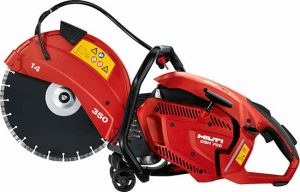 “We’ve added an auto-choke system to our new DSH 700-X and 900-X gas powered saws, which eliminates the need for the customer to worry about choking the saw or selecting the right amount of choke for each start,” says Walker. “You just simply flip the switch ‘on’ and pull the starter rope.”
“We’ve added an auto-choke system to our new DSH 700-X and 900-X gas powered saws, which eliminates the need for the customer to worry about choking the saw or selecting the right amount of choke for each start,” says Walker. “You just simply flip the switch ‘on’ and pull the starter rope.”
To defend against dust and debris, Hilti units use a Cyclone Air Filtration System to remove particulate from the engine air intake flow by way of centrifugal force. The cleanest air is suctioned from the center of the cyclone and then sent to the physical filtering system.
“This dramatically increases the filter’s lifetime and performance, meaning less downtime for contractors,” notes Walker.
The DSH 700-X is a 70cc saw and is available in 12- and 14-in. models, while the DSH 900-X is a 90cc saw in 14- and 16-in. models. On-site maintenance for both is made simple with an easy-to-access and change starter rope, air filter housing and a reinforced blade guard.
Norton Clipper
When designing the Norton Clipper, engineers found solutions to the everyday customer concerns of using two-stroke motors and high-speed saws. The 3-step easy start eliminates the hassle of a choke. The electronic carburetor’s electro-magnetic valve eliminates the standard choke and half throttle start. Operators simply turn the switch on, prime the engine, and push the decompression button, and pull the cord.
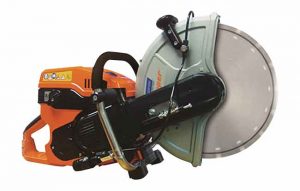 Using the patented iLube system, measuring oil and premixing is eliminated as “the machine does it for you,” notes product engineer Paul Edwards. An automatic idle function kicks in when the oil reservoir is low and needs refilling. This prevents damage to the 5.4 hp engine. The Clipper remains neutrally balanced when cutting in any angle over a 180-degree radius. Ergonomic designs have eliminated the familiar gyroscopic effect of torqueing up and to the right when throttling up.
Using the patented iLube system, measuring oil and premixing is eliminated as “the machine does it for you,” notes product engineer Paul Edwards. An automatic idle function kicks in when the oil reservoir is low and needs refilling. This prevents damage to the 5.4 hp engine. The Clipper remains neutrally balanced when cutting in any angle over a 180-degree radius. Ergonomic designs have eliminated the familiar gyroscopic effect of torqueing up and to the right when throttling up.
“Overall, it is just a better balanced machine,” notes Edwards, adding the vibration reduction system also improves ergonomics.
The multi-stage air filtration system with external rocker wheel adds to operating efficiency and extends machine life. Twin-air inlets draw fresh air in from the back of the machine and create a natural internal cyclonic effect forcing out larger particles. Air then passes through a two-stage main and micro filter process. When on idle, the external rocker wheel vibrates the filter to further help release debris. This system extends the filter life and improves performance. The Clipper comes in 12-in. and 14-in. models.
Husqvarna K970
The upgraded K970 is one of Husqvarna’s workhorses in the cutoff saw line. The most recent model features an upgraded engine platform that meets lower emission standards.
“It is more fuel efficient and runs cooler, which provides longer engine life and more dependability,” says Mike Ward, Husqvarna product manager. Used extensively by road contractors for curb cuts, the K970 can also be attached to a trolley. The wet cutting kit provides excellent dust control and features less slurry and low water consumption because of a redesigned water valve that automatically adjusts.
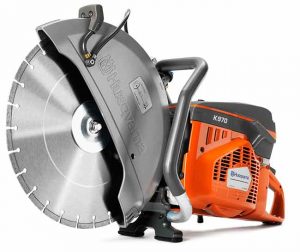 “Less water means less clean up and less environmental concern,” notes Ward. It fits 12 in. to 16 in. discs and multiple blade bushings thanks to the reversible blade bushing design. An anti-vibration system in the cutting handle allows for more comfortable long-term use. The drive belt and transmission is fully sealed to help keep out cutting dust. Likewise, the dust sealed starter, return spring and pulley bearing combined with optimum ignition timing provides virtually maintenance-free starting. The reversible cutting arm allows for closer cuts to walls and the ground. The K970 puts out 6.5 hp and weighs 24 lbs.
“Less water means less clean up and less environmental concern,” notes Ward. It fits 12 in. to 16 in. discs and multiple blade bushings thanks to the reversible blade bushing design. An anti-vibration system in the cutting handle allows for more comfortable long-term use. The drive belt and transmission is fully sealed to help keep out cutting dust. Likewise, the dust sealed starter, return spring and pulley bearing combined with optimum ignition timing provides virtually maintenance-free starting. The reversible cutting arm allows for closer cuts to walls and the ground. The K970 puts out 6.5 hp and weighs 24 lbs.
ICS 695XL
For something a little more non-traditional, the ICS 695XL concrete cutting chainsaw strikes a very different profile.
“ICS started as a product development project more than 25 years ago and we really invented the category of concrete chain saws,” explains Joe Taccogna, senior product line marketing manager. ICS also invented and patented a technology that seals out the abrasive slurry that plagued early diamond chains with stretching of chains. Productivity is key, says Taccogna. “This can mean many things from improved cutting speed to reduced downtime.”
The latest version of the 695XL has a new piston and cylinder design that lowers engine temperature and improves cooling, resulting in longer engine life and less downtime.
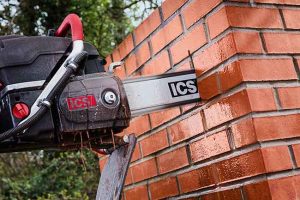 “The primary advantage of a chain saw in cutting concrete, masonry and stone is the depth of cut with a fairly small opening size,” explains Taccogna. It also facilitates cutting square corners without having to overcut.
“The primary advantage of a chain saw in cutting concrete, masonry and stone is the depth of cut with a fairly small opening size,” explains Taccogna. It also facilitates cutting square corners without having to overcut.
“There are some openings where there is simply no other tool that will do this job.” With a chain saw, you can make a cut all the way through a 10-in. wall and make an opening as small as 4 in. by 4 in. without over-cutting the corners, Taccogna explains. ICS offers gas, air, hydraulic and high-frequency electric powered saws outfitted with 12-in. to 16-in. guidebars.
Stihl TS 420
The TS 420 is a mainstay in the Stihl line-up of cut-off saws. “Our customers are still looking for a quality tool that will get the job done, day-in and day-out, and offer versatility,” notes Chad Dubois national manager, Technical Services for Stihl. “The secret to its longevity is the combination of engine design with reduced emissions and fuel consumption, state-of-the-art air filtration system and an effective anti-vibration system,” to name a few of the stand-out features.
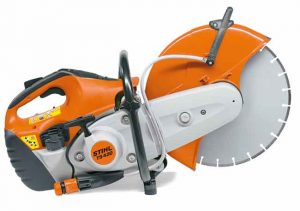 The TS 420, with the standard 14-in. disc can be hand-operated or mounted on the FW 20 cart (sold separately) for improved precision and comfort. The semi-automatic V-belt tensioning system allows for light, consistent re-tensioning that increases the service life of the belts and shaft bearings. A compensator controller in the carburetor maintains the constant ideal fuel-to-air ratio for ideal engine performance as the air filter begins to get dirty. The ElastoStart pull cord reduces the shock in user’s joints and muscles caused by the compression of the engine
The TS 420, with the standard 14-in. disc can be hand-operated or mounted on the FW 20 cart (sold separately) for improved precision and comfort. The semi-automatic V-belt tensioning system allows for light, consistent re-tensioning that increases the service life of the belts and shaft bearings. A compensator controller in the carburetor maintains the constant ideal fuel-to-air ratio for ideal engine performance as the air filter begins to get dirty. The ElastoStart pull cord reduces the shock in user’s joints and muscles caused by the compression of the engine
during starting.
Stihl is the first manufacturer of hand-held power equipment to introduce electronic fuel injection in its TS 500i. The system allows for greater fuel economy, less harmful emissions and improved performance The TS 500i is able to stay properly tuned in every operating phase, eliminating the need for manual adjustment. It also features an electronic watering system that has seven levels of water output and shuts off when the machine comes down to idle, notes Dubois.
Patrick McConnell is a Toronto-based freelance writer and editor. Send comments to editor@on-sitemag.com.




